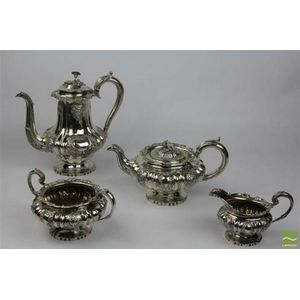Victorian Silver Tea Set with French Embossed Decoration
You must be a subscriber, and be logged in to view price and dealer details.
Subscribe Now to view actual auction price for this item
When you subscribe, you have the option of setting the currency in which to display prices to $Au, $US, $NZ or Stg.
- Finial - An architectural decoration, found on the upper parts of of an object. On furniture they are usually found on pediments, canopies and shelf supports. On smaller ceramic or silver items, such as spoons, they may decorate the top of the item itself, or the lid or cover where they provide a useful handle for removal.
Finials have a variety of shapes and forms. They may be urn-shaped, baluster shaped round or spiral, but usually taper into an upper point. Many real life shapes may also be used as finials, such as pineapples, berries, pinecones, buds, lotus and acorns. Sometimes animals such as a lion are depicted, or fish and dolphins. - Embossed / Repousse - Embossing, also known as repousse, is the technique of decorating metal with raised designs, by pressing or beating out the design from the reverse side of the object.It is the opposite of chasing, where the decoration is applied from the front. An embossed or repoussed object may have chasing applied to finish off the design.
- Victorian Period - The Victorian period of furniture and decorative arts design covers the reign of Queen Victoria from 1837 to 1901. There was not one dominant style of furniture in the Victorian period. Designers used and modified many historical styles such as Gothic, Tudor, Elizabethan, English Rococo, Neoclassical and others, although use of some styles, such as English Rococo and Gothic tended to dominate the furniture manufacture of the period.
The Victorian period was preceded by the Regency and William IV periods, and followed by the Edwardian period, named for Edward VII (1841 ? 1910) who was King of the United Kingdom and the British Dominions and Emperor of India for the brief period from 1901 until his death in 1910.
This item has been included into following indexes:
-
tea sets/services
- silver, French 13
- silver, Victorian 328
Visually similar items

A George V sterling silver tea and coffee service by Edward Barnard & Sons Ltd, London 1919/20, comprising a coffee pot, tea pot, sugar bowl and milk jug, the coffee pot 23 cm high, 2,480 grams total weight

A French silver plated centrepiece jardiniere with a mirrored tray, circa early 20th century, with mark in relief, Orfevrerie Selecta, 353. In the bombe rococo manner with pierced scrolling foliate motifs and sweeping handles and raised on acanthus feet, h

English hallmarked sterling William IV four piece tea setting comprising a hot water pot, teapot, cream jug & sugar bowl, having a round bellied bodies with hand-chased flora & fauna decoration, each with a monogrammed cartouche 'J.F.H.', silver insulated

George IV sterling silver four piece tea & coffee set consisting of tea pot, coffee pot, sugar bowl & creamer, each decorated with embossed floral panels, the pots with flower shaped finials and leaf capped handles with small ivory insulators, London, coff
